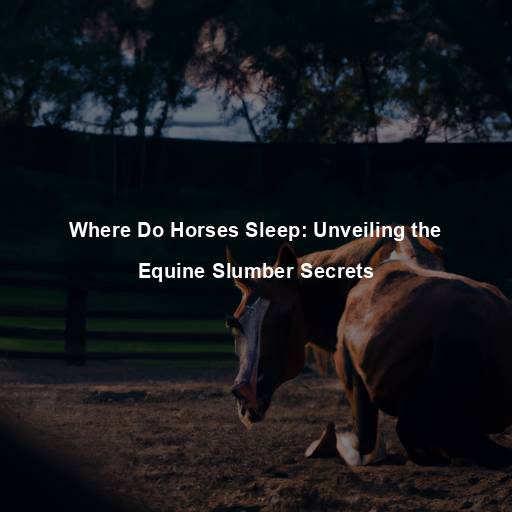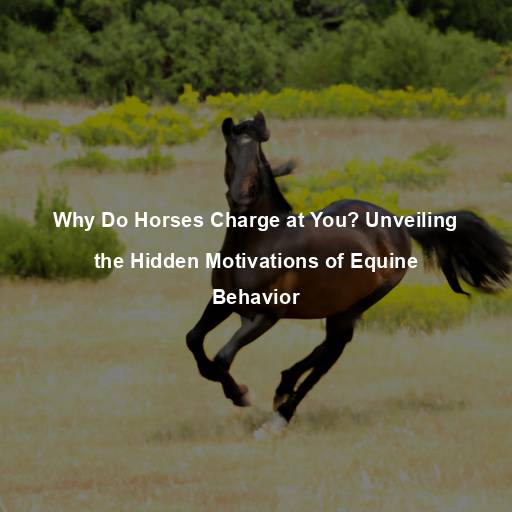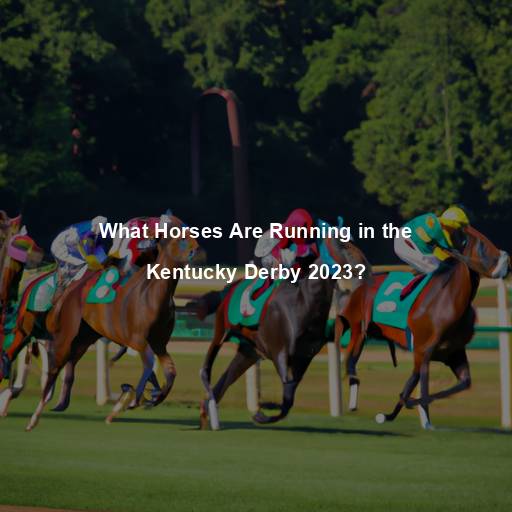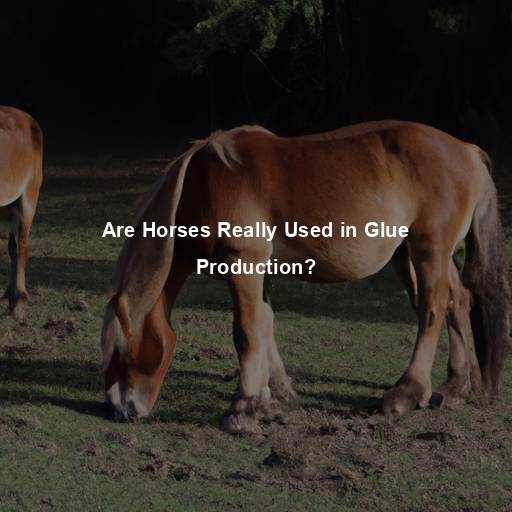Can Horses See in the Dark?
Last Updated on July 10, 2023 by Evan
Contents
- 1 Understanding Horse Vision
- 1.1 Anatomy of Equine Eyes
- 1.2 Rods and Cones: The Key to Vision
- 1.3 Horses and Night Vision
- 1.4 Adaptations for Low-Light Environments
- 1.5 Twilight Vision
- 1.6 Limitations in Complete Darkness
- 1.7 The Role of Human Intervention
- 1.8 Survival in the Wild
- 1.9 Navigating Different Environments
- 1.10 Interactions within the Herd
- 2 Factors Affecting Horse Vision
- 3 Caring for Horses’ Vision
- 4 The Fascinating World of Equine Vision
- 5 Common Misconceptions about Horse Vision
- 6 FAQs: Can Horses See in the Dark?
Understanding Horse Vision
Horses, with their majestic presence and powerful gallop, have always fascinated humans. Their ability to navigate through various terrains and environments, both day and night, is truly remarkable. One intriguing aspect of horse vision that has captured the curiosity of many is their ability to see in the dark. In this article, we will delve into the fascinating world of horse vision and explore whether these magnificent creatures possess the ability to see clearly in low-light conditions.
Anatomy of Equine Eyes
To comprehend how horses perceive the world around them, it is essential to understand the anatomy of their eyes. Horses have large, expressive eyes positioned on the sides of their heads, allowing for a wide field of view. This positioning grants them the ability to detect potential predators or threats from various angles, an advantageous trait inherited from their wild ancestors.
Rods and Cones: The Key to Vision
Nestled in the depths of the equine eye, lies the enigmatic retina, a captivating sensory canvas that unravels the mysteries of light. In this ocular symphony, two extraordinary actors take center stage: the rods and the cones. Like dancers in a grand production, the rods ardently embrace the delicate art of sensitivity, mesmerizing us with their prowess in dimly lit settings. Meanwhile, the cones dazzle us with their vibrant palette, painting the world around us with a kaleidoscope of hues, as if harnessing the very essence of sunshine.
Horses and Night Vision
It’s a common misconception that horses have the same night vision as creatures of the night. While their eyes do lend them an advantage in low-light situations, thanks to an abundance of rods, they still rely on some degree of illumination to see things clearly. In pitch-black conditions, horses might find themselves at a disadvantage, struggling to discern objects or pick up intricate details with the same level of precision as they would under the bright sun. It just goes to show that even our four-legged friends have their limits in the dark.
Adaptations for Low-Light Environments
While horses may not have the same level of night vision as animals specifically adapted to nocturnal lifestyles, they have developed several adaptations that enhance their ability to see in low-light conditions. These adaptations include a larger pupil size, which allows more light to enter the eye, and a reflective layer behind the retina called the tapetum lucidum. The tapetum lucidum reflects light back through the retina, increasing the chances of capturing photons and enhancing the horse’s sensitivity to dim light.
Twilight Vision
As the stars begin to twinkle and the sun bids its farewell, horses come alive in the magical lighting condition known as “crepuscular”. This enigmatic period of transition between day and night unlocks a hidden prowess in these majestic creatures. With their extraordinary visual adaptations, horses harness the power of twilight, where the sky is veiled in a gentle glow. Their exceptional rod-based vision, coupled with the lingering ambient light, bestows upon them the ability to traverse the world with unwavering confidence, seeing things that few can perceive.
Limitations in Complete Darkness
In complete darkness, horses heavily rely on their other senses, particularly their remarkable sense of hearing and their acute sense of smell. These senses aid them in detecting and avoiding obstacles or potential dangers. However, it is important to note that their ability to perceive fine details or colors is severely compromised without adequate lighting.
The Role of Human Intervention
In some instances, humans may assist horses in low-light situations by providing artificial lighting sources, such as lanterns or headlights. These external light sources can significantly improve visibility and help both the horse and rider feel more secure and confident in their surroundings.
Survival in the Wild
Throughout history, horses have been prey animals, facing constant threats from predators. Their survival depended on their ability to quickly detect and respond to potential dangers. The wide field of view provided by their position of eyes on the sides of their heads allowed them to monitor their surroundings for any signs of danger. This evolutionary adaptation, coupled with their keen sense of hearing and smell, enabled horses to thrive in the wild.
Horses are highly adaptable creatures, capable of living in various environments, from open grasslands to dense forests. Their vision plays a vital role in navigating these diverse landscapes. The ability to see clearly in low-light conditions allows them to move confidently through dimly lit areas, such as dense forests or shaded areas. Horses rely on their visual acuity and depth perception to avoid obstacles and select the safest paths.
Interactions within the Herd
Horses, intriguing creatures of the wild, are known for their captivating social dynamics. These majestic animals find solace and strength in the company of their herd, forging lifelong bonds that shape their very existence. It is through the window of their eyes that horses reveal a hidden language, an intricate dance of body language and expressions, allowing them to navigate the delicate hierarchies within their group. Their visual communication becomes an enchanting spectacle during moments of nourishment, courtship, and playful exchanges, illuminating the true essence of these bewitching equine beings.
Factors Affecting Horse Vision
Horses have the ability to see in low-light conditions, but they do not have true night vision. They rely on some degree of illumination to see clearly, and in pitch-black conditions, they may struggle to discern objects or pick up intricate details. Horses have adaptations that enhance their vision in low-light environments, such as a larger pupil size and a reflective layer called the tapetum lucidum. It is important to prioritize their eye health by providing regular veterinary check-ups, adequate lighting, and protection from UV exposure. Understanding horse vision can help humans communicate effectively and build a strong bond with these remarkable creatures.
Age and Eye Health
As horses gracefully grow older, they may encounter a perplexing challenge similar to that faced by us mere humans – a decline in their visual prowess. Unraveling this equine enigma, we uncover a world of ocular ailments that plague these majestic beings, from the enigmatic cataracts to the intricate web of glaucoma. By seizing the reins of proactive measures such as routine eye examinations and attentive care, we can embark on a quest to preserve the visual splendor of these wondrous creatures, thus safeguarding their enigmatic charm.
Lighting Conditions
While horses have adapted to see in low-light conditions, the quality and intensity of the lighting can still affect their visual perception. Bright sunlight can create shadows and highlights, making it challenging for horses to discern objects or judge distances accurately. Similarly, extremely dim or uneven lighting can limit their ability to see details and navigate their surroundings effectively.
Eye Injuries and Visual Impairments
In the world of majestic creatures, even the noblest of horses can fall victim to the enigmatic realm of eye injuries. Their sights, as powerful as they may be, are not impervious to the whims of fate. Whether it be the mischievous intrusion of foreign objects, the brutal sting of trauma, or the insidious invasion of infection, their visual prowess can be both imperiled and perplexed. It is imperative, therefore, that swift veterinary intervention and tailored treatment be employed to preserve not only their magnificent vision but also their very essence of existence.
Caring for Horses’ Vision
Regular Veterinary Check-ups
Similar to how people go to the eye doctor for regular check-ups, horses also need to undergo routine veterinary examinations to ensure their eye health. These appointments, carried out by skilled veterinarians specializing in equine ophthalmology, involve thorough assessments to detect any possible issues and suggest suitable treatments or preventative measures. Ensuring that our equine friends receive proper care for their eyes is essential, as it plays a significant role in their overall well-being and quality of life.
Providing Adequate Lighting
When housing horses in stables or barns, providing sufficient lighting is essential. Well-lit environments not only enhance visibility for the horses but also contribute to their overall well-being and mental health. Adequate lighting can help reduce accidents, improve feeding routines, and create a comfortable and safe living space for these magnificent animals.
Protecting from UV Exposure
When it comes to horses, the sun can be a sneaky foe, especially for those with light-colored coats or sensitive skin around their eyes. The pernicious ultraviolet (UV) radiation can wreak havoc on their health, causing issues like squamous cell carcinoma or irritating conjunctivitis. Luckily, there are ways to shield our equine companions from the sun’s wrath, such as donning fly masks or generously applying equine-approved sunscreen. By taking these preventative measures, we can bask in the joy of knowing our horses are protected from the perplexing perils of UV rays.
The Fascinating World of Equine Vision
Delving into the enigmatic world of horse vision unravels a tapestry of astonishing adaptations, offering a glimpse into how these majestic creatures perceive their surroundings. Although horses don’t possess authentic night vision, their uncanny ability to navigate in dimly-lit settings speaks volumes about their evolutionary prowess and survival mechanisms. As guardians of these awe-inspiring beings, it falls upon us to prioritize their ocular well-being, ensuring adequate illumination and promptly seeking professional veterinary care whenever necessary. Through tending to their visual needs, we can safeguard a future where horses continue to captivate with their elegance and allure for generations to come.
Flight Response
The incredible visual acuity of horses, intricately tied to their innate flight response, is a testament to their evolutionary survival tactics. Rooted in the depths of their genetic makeup, this exceptional capability allowed their untamed predecessors to artfully evade predators. Astonishingly, even in the realm of domestication, these noble creatures have clung onto this primal instinct, relying heavily on their panoramic vision to expertly evaluate their surroundings and confidently navigate the world around them with lightning-fast discernment.
Herd Dynamics
There is something truly captivating about horses – these majestic creatures possess a remarkable social nature, finding solace and connection within their herd. Their keen eyesight and unparalleled ability to discern the subtlest of body language cues are the key ingredients that uphold the delicate balance of their intricate social fabric. Every interaction, whether it be asserting dominance or conveying needs and intentions, relies on the power of visual communication, weaving a tapestry of bewildering social dynamics that leave us in awe.
Bonding with Humans
Horses have a remarkable capacity to form deep bonds with humans, often becoming trusted companions and partners. Building a strong bond with a horse often involves establishing trust through clear and consistent communication. Understanding how horses perceive the world visually can help humans communicate effectively and build a solid foundation of trust and respect.
Common Misconceptions about Horse Vision
Horses Can See Everything
It’s time to debunk the myth about horses having supernatural vision! Although they boast a wide field of view, don’t be fooled into thinking they’ve got eyes in the back of their heads. Their visual abilities differ from ours, and while they may not see the world in high-definition, they have a knack for utilizing their other senses and environmental clues to navigate their surroundings. So, next time you find yourself in the presence of these majestic creatures, remember their uniquely equine perspective!
Horses Can See in Complete Darkness
As the sun dips below the horizon and darkness descends upon the world, horses find themselves in a realm of perplexity and diminished sight. While their remarkable adaptations allow them to thrive in the twilight and dimly lit spaces, venturing into the abyss of complete darkness unveils their limitations. They must rely on their acute senses of hearing and smell, like intrepid explorers navigating an enigmatic realm.
Horses Can Only See in Black and White
There is a rather perplexing notion circulating that horses can only experience the world devoid of color. However, let me burst that bubble and enlighten you. It turns out, horses possess a peculiar knack for perceiving certain hues, contrary to the popular belief. They possess not one, but two types of cones in their eyes, allowing them to observe a limited spectrum of colors, albeit narrower than our own vivid human vision.
FAQs: Can Horses See in the Dark?
Can horses see in the dark?
Yes, horses have better night vision than humans. They possess a unique adaptation called “night vision” which allows them to see fairly well in low-light situations. Horses have larger eyes and a higher number of rod cells in their retinas compared to humans, which aids in their ability to see in the dark.
Did you know that horses possess some remarkable adaptations that aid them in navigating through dimly lit environments? Not only do they boast large eyes to capture a wealth of available light, but their eyes also possess a tapetum lucidum, a reflective layer located right behind the retina, which enhances their ability to see in darkness. Furthermore, the positioning of their eyes on the sides of their heads grants them a broader field of vision, allowing them to effortlessly detect movement, even in the darkest of nights. It’s fascinating how these equine creatures have evolved to excel in low-light conditions, isn’t it?
Can horses see in complete darkness?
As the moon rises, a mysterious enchantment falls upon horses, revealing their secret nocturnal powers. Their eyes, though not impervious to darkness, possess a remarkable ability to perceive the world amidst the moon’s pale glow or the gentle twinkle of distant stars. While we may stumble and grope in the shroud of night, these majestic creatures navigate with grace, their vision embracing the twilight realm with unmatched prowess. A wondrous reminder that even in the cloak of darkness, nature unfurls its captivating surprises.
Are all horses equally capable of night vision?
When it comes to night vision, horses often prove themselves to be masterful creatures of the dark. Their extraordinary ability to adapt to low-light environments is nothing short of astonishing. Yet, within each herd, a peculiar mystery unfolds; a symphony of individuality that holds the answers to the varying degrees of equine night vision. It is in the intricate dance between age, health, and genetics that the riddle unravels, revealing a tapestry of unique perception in the equine realm. Despite this enigmatic puzzle, horses remain formidable ambassadors of the night, effortlessly traversing the moonlit landscapes with an air of bewildering grace.
Are there any circumstances where a horse’s night vision may be compromised?
Yes, there are certain circumstances that can hinder a horse’s night vision. For example, eye diseases, injuries, or infections can affect their ability to see clearly in any lighting conditions, including the dark. Similarly, if a horse is stressed, anxious, or fearful, it might affect their visual acuity. It is essential to ensure proper care and regular veterinary check-ups to maintain a horse’s overall visual health.
Can horses see better in the dark than predators?
When the moonlight casts its ethereal glow, horses come alive, tapping into their innate abilities that grant them an upper hand in the darkness. Their eyes, like ancient jewels, harbor a remarkable advantage – a panoramic view of their surroundings, unveiling the secrets that hide within the shadows. Yet, the nocturnal theater is not solely meant for equine mastery, as formidable predators with sharpened fangs or wide-staring eyes lurk in the ebony abyss, wielding nocturnal prowess that surpasses even that of the majestic horse. Therefore, for horses to navigate these enigmatic realms, they must call upon their ingrained instincts, relying on their ancient flight mechanisms to elude potential danger lurking in the veiled moonlight.






